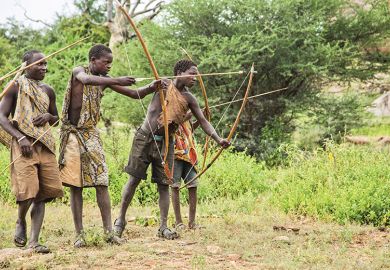This volume is an excellent addition to the increasing number of reliable publications on theatre and the performance arts in Africa. Different readerships require different levels of knowledge, and this volume offers detailed information written in accessible language. For the specialist - whether student, researcher or lecturer - the articulation of some of the more difficult descriptive terminologies applied to some of the most difficult categorisations is rich, tempting and provocative. For readers less familiar with, or even misinformed about African theatre, the substantial range of material presented should enable a process of (re)-informing themselves.
The book is arranged in ten sections - some have only one article, others up to four. The arrangement is essentially geographical (north, west, east and southern/south) with an additional linguistic distinction between some of the geographic clusters, so that Francophone, Anglophone and Lusophone Africa are represented in separate sections, as well as in an unexpected and welcome solo article, "Mauritius and Reunion".
It is also satisfying to see three entries from north Africa covering Egypt, Morocco, Algeria, Tunisia and Sudan.
If the editor has suggested a chronological approach - inevitable perhaps for a history - the period of the colonisation of Africa by various European countries is the pivot. Many writers, however, resist writing about what David Kerr calls "theatre in neat historical phases". In his article on theatre in Francophone Africa, John Conteh-Morgan's rejection of an "evolutionary perspective" and his embrace of a "plurality of theatre forms (that) will be discussed on their own terms... and not constituting points of origin or arrival" includes his stance that "the literary theatre will not be erected into the norm in relation to which all others will be judged".
Although this theatrically informed, anti-evolutionary stance is vigorously adopted by most contributors, a historical focus remains easily read as a ubiquitous "evolutionary" agenda. Kerr states emphatically that for the ngoma practices, it was not the case that the "indigenous forms began to wither away, but rather that they found countless ways to adapt to innovation and modernity". A similar point is made in Mohammed Sheriff's article on Sierra Leone, where he notes how audiences can find ritual performances both "awesome and amusing" and how, in some instances, ritual performances have been "freed from their immediate task of function and...
presented to a wider audience for entertainment" but without relinquishing their use in an original context. He thus denies readers any inclination towards a "disappearing world" nostalgia. Such transformed ritual performances - often toured internationally as exemplary of a country's performance arts - present, perhaps unavoidably, an uneven picture of contemporary practice.
Ahmed Zaki's article on Egyptian theatre is among many outstanding contributions. Referring to forms of "public ceremonies", he notes the introduction of "Turkish glove puppets" and the presence of only one "acting group" in the early 19th century - "players of low farce", men and boys impersonating women "who got their laughs from vulgar gestures and sexually indecent actions". Later there were "local and provincial groups" as well as "foreign troupes" visiting Cairo from Damascus and Beirut, and later still came "more naturalistic plays".
Kamal Salhi's splendid article on Morocco, Tunisia and Algeria begins by setting out helpful parameters for the use of "theatre", noting a collective difference from "most of the rest of Africa". Then, pursuing a coherent historical trajectory, he simultaneously raises issues of language, of participation, of payment, of directing and of artistic independence. He rightly brushes aside as redundant any apologies for "new forms" because, as he says, "the test is whether or not they make sense of reality for participants and observers".
James Gibbs' article on Ghana opens with a series of stimulating observations about the impact of contemporary non-theatrical influences on annual festivals, events for which Ghana is rightly famous and that, as Gibbs so eloquently puts it, "bear the freight of the past". However, he gives a timely warning to the reader to be aware of a "bias" in "scholarly analysis" towards "the most accessible ethnic groups" (in the south). He describes the importance of the Ananse tales, of the "concert party" genre (a fun mix of vaudeville, music hall and political satire), and the contribution to different fields of theatre practice by key figures such as Efua Sutherland, John Collins and Sandy Arkhurst.
Among the stimulating contributions on east Africa, Amandina Lihamba gives an account of how in the early 20th century in Tanzania migrant people from many different ethnic groups shared performances as they sought out paid labour in the growing urban centres. She describes how "the snake dances of the Wasukuma and Wanyamwezi people... and the mask dances of the Wamakonde... were popular performances amongst immigrants" and that, as well as these, "there developed performances of a multiethnic nature... new creations that sprang up as part of the political and economic changes...".
Her coverage of post-independence theatre includes radio drama and the work of playwrights writing in both Kiswahili and English, as well as the multi-faceted contribution of the Bagamoyo College of Arts.
Another comprehensive article is Eckhard Breitinger's on Ugandan theatre.
He analyses the plays of Robert Serumaga and Okot p'Bitek as well as the pioneering work of Wycliffe Kiyingi and Byron Kawadwa before noting the unique contribution of Rose Mbowa to contemporary drama and, from among the younger dramatists, mentions Charles Mulekwa's return to "dialogue drama".
Written along with Stephen Chifunyise, Kerr's article is surely set to become the definitive synoptic account of theatre in southern Africa.
Analytical, descriptive and historical, he gives a fascinating account of the politicisation of the Swazi Incwala ceremony during the 1980s as, within Swaziland, at the succession of the new king Swati, his councillors "sought cultural ways to stem the rising tide of republicanism" and how "Swazi cultural experts" advised the Ngoni people in Zambia how to revive the same ceremony, "seventy years after it had last been performed".
There are informative articles on Camerounian, Kenyan and South African drama, but the Nigerian article should be renamed "Yoruba" to reflect its dominant content. Even acknowledging the richly deserved reputation of the Yoruba contribution to African theatre, such a specific focus in this volume is inadequate in representing a country with around 500 ethno-linguistic groups, many with wonderful performance arts.
In spite of an unresolved tension between "evolutionary" and "historic", all the contributors emphasise the continuing creative nature of theatre in their part of the African continent, thus dispelling any lingering desire to use such words as "traditional" and "modern" either to suggest an inherent dichotomy or as accurate terminology.
This stimulating book is recommended to readers seeking to acquire greater knowledge of the practice of theatre of all kinds in Africa or to address the issues surrounding theatre scholarship in and from the continent. In particular, the growing body of those teaching about the performance arts of Africa in the UK, US and Africa itself will find it an invaluable resource for identifying and exploring core issues.
Frances Harding is lecturer in African drama, School of Oriental and African Studies, University of London.
A History of Theatre in Africa
Editor - Martin Banham
Publisher - Cambridge University Press
Pages - 478
Price - £80.00
ISBN - 0 521 80813 8
Register to continue
Why register?
- Registration is free and only takes a moment
- Once registered, you can read 3 articles a month
- Sign up for our newsletter
Subscribe
Or subscribe for unlimited access to:
- Unlimited access to news, views, insights & reviews
- Digital editions
- Digital access to THE’s university and college rankings analysis
Already registered or a current subscriber?



